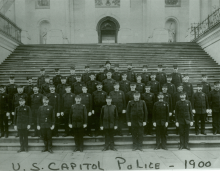Our History
The United States Capitol Police (USCP) dates back to 1800 when the Congress moved from Philadelphia to Washington, D.C. A lone watchman, John Golding, was hired to protect the Capitol Building. After a number of incidents occurred in 1827 that could have been prevented with sufficient security and surveillance, President John Quincy Adams asked that a regular Capitol Police force be established.
On May 2, 1828, Congress passed an Act that expanded the police regulations of the City of Washington to include the Capitol and Capitol Square. It is on this date that the USCP commemorates its founding.
 With the passage of this Act, Congress brought the responsibility of policing the Capitol under the direction of the presiding officer of the House and Senate, and empowered the Capitol watchmen with full law enforcement authorities. The new force consisted of a captain and three men who worked fifteen-hour shifts when Congress was in session and ten-hour shifts at all other times. Their area of authority did not exceed the neighboring walks and streets adjacent to the Capitol Building.
With the passage of this Act, Congress brought the responsibility of policing the Capitol under the direction of the presiding officer of the House and Senate, and empowered the Capitol watchmen with full law enforcement authorities. The new force consisted of a captain and three men who worked fifteen-hour shifts when Congress was in session and ten-hour shifts at all other times. Their area of authority did not exceed the neighboring walks and streets adjacent to the Capitol Building.
The responsibility of the Capitol Police was transferred from the Commissioner of Public Buildings to the Sergeants at Arms for the U.S. House of Representatives and the U.S. Senate in 1867. In 1873, the Capitol Police Board was established, and the Architect of the Capitol was added to the Board.
By 1935, the Capitol Grounds footprint was expanded to 126 acres. As a result, the head of the Department requested additional officers to augment the 132-man force, which consisted of men ranging from 19 to 75 years old. The Captain of Police also asked to adopt the same standards held by the Metropolitan Police Department of the District of Columbia (MPD), and Congress authorized the Capitol Police Board to establish specific qualification requirements. The Act of July 31, 1946, recodified the earlier  authorities and responsibilities of the Department in one Act and formed the fundamental basis for the statutory authorities and responsibilities of the Department and Capitol Police Board to such an extent that subsequent authorities generally have been conferred as amendments to this Act.
authorities and responsibilities of the Department in one Act and formed the fundamental basis for the statutory authorities and responsibilities of the Department and Capitol Police Board to such an extent that subsequent authorities generally have been conferred as amendments to this Act.
In 1974, the Department's first female Capitol Police officers were hired, thereby providing new opportunities for women wanting law enforcement careers. In 1979, President Jimmy Carter signed Public Law No. 96152, establishing a chief of police for the United States Capitol Police. The role had previously been held by MPD Captains and Assistant Chiefs in an ex-officio capacity. Public Law No. 96152 was the catalyst for the Department’s transition into the modern era.
The USCP expanded its force after the terrorist attacks on September 11, 2001, and again following the historic merger with the Library of Congress Police in 2009. Currently, the Department has an authorized sworn strength of more than 2,000. In addition to the sworn members of the force, the Department has over 350 civilian personnel who provide operational and administrative support. The USCP’s diverse workforce is comprised of employees from nearly all 50 states and the U.S. territories.
 Today, the USCP embodies the best in American policing and serves as a model in security, urban crime prevention, dignitary protection, specialty response capabilities, and homeland security. We proudly protect the legislative process, the symbol of our democracy, the people who carry out the process, and the millions of visitors who travel here to see democracy in action each day. Acting on the world stage in an open environment and ensuring that each interaction we have leaves a lasting impression that is reflective of the Legislative Branch is an essential part of our values and is critical to achieving our mission.
Today, the USCP embodies the best in American policing and serves as a model in security, urban crime prevention, dignitary protection, specialty response capabilities, and homeland security. We proudly protect the legislative process, the symbol of our democracy, the people who carry out the process, and the millions of visitors who travel here to see democracy in action each day. Acting on the world stage in an open environment and ensuring that each interaction we have leaves a lasting impression that is reflective of the Legislative Branch is an essential part of our values and is critical to achieving our mission.


